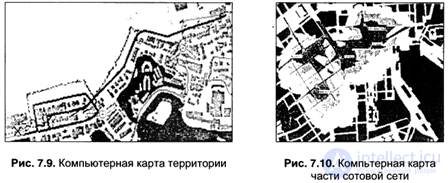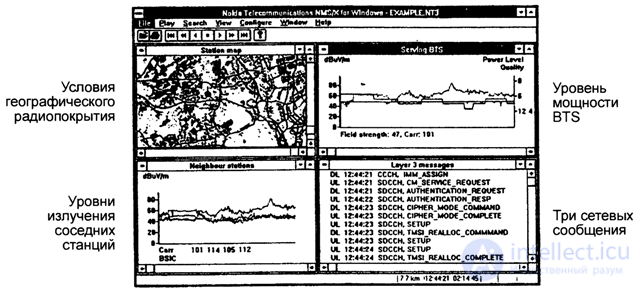Lecture
When designing a cellular mobile network, the following basic operations should be performed [7.9]: cost estimation of the designed network; network capacity assessment; assessment of radio coverage and location of cellular network elements; assessment of the maximum allowable density (degree of service); call number evaluation; assessment of the future development of the cellular network. According to NOKIA specialists, the main stages of the network planning process are as follows:
1. Collect information on the following sections:
- rules and laws;
- key information on demography, income level, forecast of expansion of the service area, support services, marketing research, etc .;
- the presence of leased lines of communication, the presence of microwave frequencies, the requirements of connections with other systems;
- number, address and routing principles;
- topographic maps;
- existing infrastructure, such as transmission networks and transmission media.
2. Determination of the required basic network parameters for radio coverage and capacity.
The main problem of this planning stage is network optimization by the criterion of cost-effectiveness. In order to realize this task in practice, detailed information about the cellular network is necessary (an increase in the cost of the plan stage, the protection available, the necessary information infrastructure), as well as the formulation of network objectives and quality requirements. The result of the second stage is the design of the integrated network topology, in which various services and the equipment required for its implementation should be shown. In addition, an initial network implementation plan should be presented. The main objective of this phase is to illustrate the integrated cellular network planning process. Other types of planning should also be noted:
- FTP (Fixed Transmission Planning) - fixed transfer planning;
- NAP (Network Access Planning) - network access planning;
- DCN (Data Communication Network Planning) - planning a data network;
- INP (Intelligent Network Planning) - planning an intelligent network;
- 3G and IP Network Planning - planning the development of a third-generation cellular system (3G), the use of IP network protocols, etc., which should be included in the full process of designing a cellular network.
3. Selection of MSC, BSC and base station locations.
4. Location survey for given MSC, BSC and base stations, in other words, assessment of MSC, BSC and BTS locations taking into account the environment surrounding these systems.
5. Detailed cellular network planning. This stage includes the following operations:
- computer network design and tools for creating the necessary radio coverage of the territory;
- analysis of interference (co-channel, external, noise);
- frequency planning;
- planning of microwave channels;
- Documentation, etc.
NOKIA has prepared the TOTEM kit, which includes the necessary tools for planning a cellular network. Below are three areas in cellular network planning:
- SNP (Switching Network Planning) - network switching planning;
- CTNP (Cellular Transmission Network Planning) - cellular transmission network planning;
- RNP (Radio Network Planning) - radio network planning.
Features planning network switching system.
During this planning stage, the following tasks should be solved:
- by measuring and taking into account the required network capacity (average talk time, number of handovers, short message transmissions, etc.), the amount of switching is estimated;
- set the level of network execution in accordance with the specified switching capacity of the network;
- Consideration is given to the implementation of switching and signaling systems;
- rules for routing, protection, synchronization and control of switching are fulfilled;
- matrices of speech and signaling traffic are determined;
- estimated the necessary equipment for the implementation of the above tasks.
After the cellular network is marked up (Fig. 7.9, 7.10), a detailed plan with
selected number of inputs (for example, network diagram, routing plan, digital analysis, control details, numbering plan, load plan, etc.). In addition, a specialist planning a network switching system should, in addition to performing the above tasks, consider a possible future expanded network plan.

Network transmission planning.
When planning a cellular transmission network, the main problem is the development of the use of microwave communication lines (or fiber-optic communication lines) in the GSM network, providing, for example, the interaction between the BTS and BSC. There are several ways to plan:
- installation of own microwave relay links (microwave microwave links);
- rental of already existing radio relay lines, which fit into the developed cellular network by location and conditions of stable radio communication;
- laying of fiber-optic communication lines.
When performing this network planning item, it is necessary to take into account the problem of connecting and coordinating large flows of various information. At this stage, it is necessary to develop a scheme of the main transmission network for BTS access and network nodes, which will allow to obtain a clear image of network connections. It is also necessary to determine the required network capacity.
Both synchronization principles, gateway and switching connections must be identified. When planning microwave channels, it is necessary to select highly reliable broadband channels to ensure reliable communication between the BTS and the BSC. In addition, fiber-optic channels can be used in the cellular network instead of radio-relay channels.
Radio network planning.
The type and location of the BTS depends on the environmental characteristics. Under city conditions, cells are usually smaller in size than in rural areas. In addition, the amount of traffic also affects the number of radio channels in a regular cell. Since, in the GSM standard, the maximum theoretical distance from the BTS to the edge of the macro cell is 35 km, the ability of the MS to send packets that should arrive in the BTS in the correct slot is usually adapted to it.
Factors limiting cell sizes:
1) with an increase in the operating frequency, that is, with a decrease in the working wavelength, the cell size decreases (the GSM 900 cell size is larger than the cell size for GSM 1800 and 1900);
2) external conditions: for open water spaces, the attenuation of radio signals is less than in forest areas or in urban environments.
Thus, when planning a radio network in a cellular communication system, it is necessary:
- implement the choice of radio channels by creating your own microwave microwave relay lines, either by renting existing ones, or laying fiber-optic communication lines;
- issue a detailed network plan, including the results of the previous paragraph, as well as the results of measurements and testing of radio coverage of the territory.
Determination of traffic and the number of channels in cells
The cell is the basic “building block” of the GSM network. One cell is essentially a geographic area surrounding a single BTS, and the size of the cell depends on the following factors:
- from the environment;
- from the number of users;
- on the operating frequency range;
- from BTS transmitter power, etc.
The cells are grouped around the base station controller BSC. The average size of a cell is found in the answer to two fundamental questions: How big is the traffic of channels (TCH - Traffic CHannel), which should be managed within the cell? What set of channel traffic does a cell need? To answer these questions, it is necessary to determine the amount of traffic in a cell.
Traffic can be calculated using a simple formula: 
where (k) (call / hour) is the average number of calls per hour; (t) is the average talk time (hour). Quantitatively, traffic does not depend on the duration of the observation. For example, if the study is conducted within 15 minutes, then in the formula for traffic A, the denominator instead of 3600 s will be equal to 900 s.
Consider a numerical example. Let 540 calls per hour be realized in a cell, and the average duration of calls is 100 s (100/60 = 1.66 min), then the traffic volume consists of: 
If you use the table. 7.1 (Erlang model B) maximum traffic density, we get: the number of channels Nk_c = 20, with a probability of failure Pb = 5%. Thus, in this case, the GOS value = 5% (Grade Of Service — quality of service), determined by the probability of failure, indicates that, with an observation time of 1 hour, 5 out of 100 calls were refused due to lack of cell resources , while the number of channels will be 20. Since in the GSM standard, each radio channel supports 8 (voice) channels, a rough estimate of the BTS equipment can be made: if three transceivers are used in the BTS, Nk-c = 3x8 = will be provided 24 voice channels, which is more than the calculated value, is equal to th 20 channels. This provides a certain margin in terms of traffic volume, since with Nk_r = 24 and Pb = 5%, the amount of traffic will be L = 19 Erl (from table 7.1).
Frequency reuse.
Each base station subsystem BSS has a limited number of allocated frequencies. These frequencies must be distributed between each cell so that the required network capacity satisfies the different parts of the BSS.
Consider the following example. In fig. 7.11 shows a cellular network.

Fig. 7.11. The scheme of the cellular network.

Fig. 7.12. An example of uniform radio coverage of a territory with a selected frequency plan.
Let the network designer choose a cluster of order 9, that is, the number of allocated frequencies is 9 (for BSS). In fig. 7.12 shows a cluster frequency distribution using the principle of frequency repetition. The next step is to estimate the LA (Local Area) - the local area of the network, which is performed in accordance with the traffic characteristics of each area. The final phase in planning a fixed network is to estimate the required traffic and the radio network.
Optimization and development of the network.
The network planning described above is only the first part of a long process of improving the cellular network being created. With further improvement of the designed cellular network, the following factors should be considered.
1. Increasing the number of subscribers requires expanding the network in a given place and in a given period of time.
2. Accounting for the cost of the network for any operator is a competitive parameter in the market of mobile communication services.
3. Network capacity, on the one hand, needs to be minimized (to provide the necessary traffic), and on the other hand, it should not be a small amount, as this will worsen the quality of service (grade of service) of subscribers.
That is, there are conflicting requirements:
- the network must be of high quality and have a wide radio coverage;
- but at the same time to reduce the cost of the network should not be redundant.
4. The need to ensure the quality of services (quality of services) is associated with the requirements of reducing interference at the radio interface and reducing the number of ringing signals per unit of time while ensuring optimal cost.
5. For basic and additional services, current and future requirements must be met.
Currently, large investments are being made in the direction of using high-speed data networks, which include:
- HSCSD (High Speed Circuit Switched Data) - high-speed data switching circuits;
- GPRS (General Packet Radio Services) - a common packet radio service;
- EDGE (Enhanced Date Rates for Global Evolution) - improved data transfer for the global evolution of communication systems (384 kbit / s);
- SDH (Synchronous Digital Hierarchy) - synchronous digital hierarchy (using fiber-optic communication lines between nodes in a cellular network), etc.
The main reason for the introduction of high-speed data transmission systems is the increase in the number of users and the associated growth in traffic and the volume of various services in cellular mobile communication systems.
Therefore, to optimize and develop the cellular network, you should:
1) conduct field tests of the created network (rather expensive), which would make it possible to clarify not only the quality of information transfer, but also hardware problems, as well as the possibility of compressing (gathering) information, increasing the number of users with a constant network structure and hardware, etc. .
2) to use the information obtained in the NMS (Fig. 7.13), by assessing the conditions of geographic radio coverage (station tar), by the BTS power level (serving BTS), by the neighbor stations for three network messages.
This information allows you to implement network performance management from the NMS (network management), to obtain important information about the health of various parts of the cellular network, which ultimately determines possible alternative solutions for the network operator.

Fig. 7.13. An example of an assessment of the conditions of geographic coverage, the power level of the BTS and the emission level of neighboring stations.
Comments
To leave a comment
GSM Basics
Terms: GSM Basics